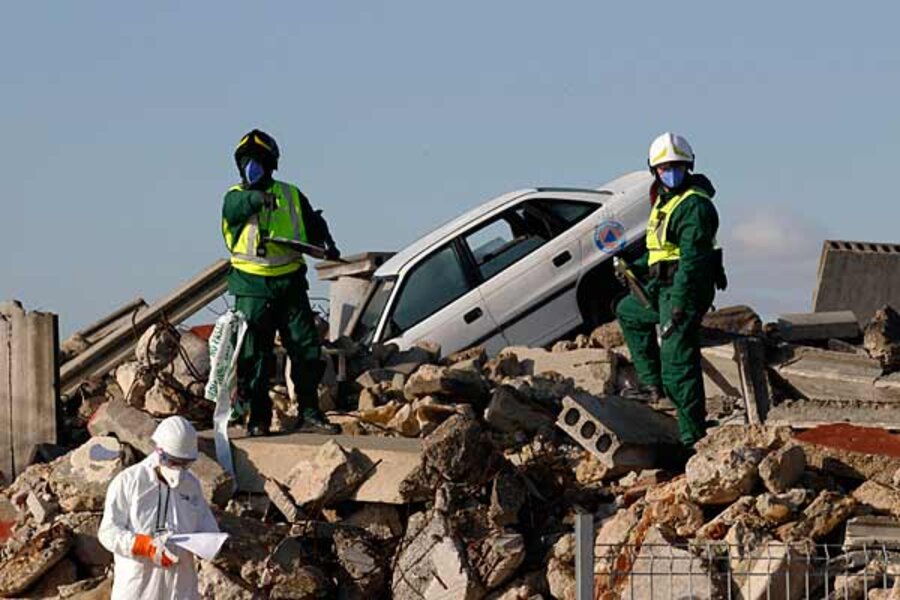Why Obama's bid to prevent loose nuclear weapons is going slowly
Loading...
One of the greatest threats facing the United States is the possibility that a terrorist organization could steal a nuclear warhead or other dangerous materials from poorly-secured stockpiles throughout the world and use it to build a device that could harm millions.
That is the assessment of a little-noticed US Government Accountability Office (GAO) report released earlier this month.
The threat was front and center in President Obama’s mind in April, 2009 when he unveiled a plan developed by the National Security Council to secure all vulnerable nuclear materials throughout the world within four years.
The GAO report examines how this strategy is progressing – and whether it is realistic.
Its conclusion is that while there has been progress, the plan, coordinated by the National Nuclear security Administration (NNSA) and stretching across the Defense, Energy, and State Departments, lacks some key details. These include identifying precisely where the vulnerable materials, including highly enriched uranium (HEU) and plutonium are – and knowing exactly how much of them various countries have.
This information is difficult to convince other countries to share. In China and India, for example – two countries believed to have large nuclear material stockpiles, according to the GAO report – “political sensitivities have limited NNSA’s efforts in both nations to the relatively non-controversial exchange of nuclear security best practices.”
For this reason it is also tricky, say US officials, to get a firm grasp on how much loose HEU and plutonium is floating around in places like the former Soviet republics. As a result, NSC officials told GAO investigators that they believed developing a comprehensive government plan for securing nuclear materials “could take years.”
Nuclear security experts largely concur. The Obama administration cites as a goal its plan to secure so-called “vulnerable” nuclear materials by 2013. “But a lot depends on what do you mean by vulnerable?” says Charles Ferguson, President of the Federation of American Scientists and a former naval officer who worked on ballistic missile submarines. “It fits on a bumper sticker: ‘Secure all vulnerable nuclear materials in four years.’ That has a nice ring to it.” He adds, however, “We can be constructive critics. What do you mean by secure? What security practices?”
The NNSA is now running more than 20 programs worldwide that include efforts to better secure nuclear warheads, dispose of radiological sources, reduce the risks of nuclear smuggling and, in the words of the GAO report, “redirect weapons of mass destruction expertise to more peaceful research.” This includes countries like Iraq and Libya, adds the GAO in one of the study’s asides.
The majority of the current focus is on securing state stockpiles of nuclear materials. Since terrorists don’t have the resources to build their own nuclear reactors and harvest their own plutonium, say experts, it stands to reason that they would target stockpiles nation states already have by stealing or smuggling it.
The frightening ease with which this can potentially be done was illustrated in a court case last month in the former Soviet Republic of Georgia, in which two Armenian buyers were convicted of purchasing HEU in a lead-lined cigarette case just before they were arrested by undercover agents. It was a successful sting operation, but the trial highlighted the porous borders of the Caucuses and raised questions about whether the HEU was part of a larger stash – and precisely how much more HEU remains unsecured from the Soviet era.
Equally troubling is Pakistan’s expanding nuclear arsenal, says Graham Allison, author of "Nuclear Terror: The Ultimate Preventable Catastrophe," and director of the Belfer Center for Science and International Affairs at Harvard University’s Kennedy School of Government. Pakistan’s nuclear stockpile is “the most rapidly expanding of any on earth, even as the country is more and more at risk” – particularly as headquarters for al Qaeda and the Pakistani Taliban, Allison says.
The bright side, say experts, is that nuclear terrorism is quite difficult to accomplish. “It’s hard to get enough materials to make an improvised nuclear device. And even if they can, there are a number of technical things that can trip them up along the way. Terrorists tend to prefer well-proven techniques” that involve conventional bombs and assault rifles, Ferguson says. “They want to make sure they have a chance of doing it right,” which has so far dissuaded groups from going down the path of nuclear terrorism, he says.
The danger is that if one group succeeds, even on a small scale, “It may open the floodgates,” says Ferguson. “It will prove it can be done and other groups will want to copy it.” This would in turn create the predictable and devastating potential, adds Allison, "for killing hundreds of thousands of people in one fell swoop.”





